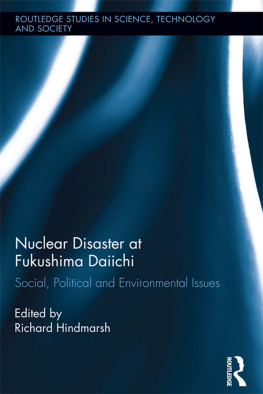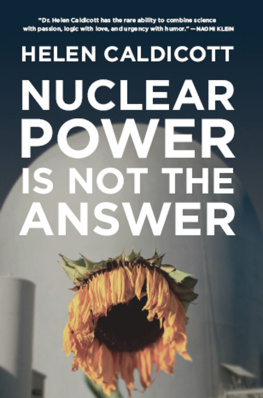CRISIS WITHOUT END


Compilation 2014 by Helen Caldicott. Adapted from the symposium The Medical and Ecological Consequences of Fukushima, held at the New York Academy of Medicine, March 1112, 2013.
All rights reserved.
No part of this book may be reproduced, in any form, without written permission from the publisher.
Requests for permission to reproduce selections from this book should be mailed to: Permissions Department, The New Press, 120 Wall Street, 31st floor, New York, NY 10005.
Published in the United States by The New Press, New York, 2014
Distributed by Perseus Distribution
LIBRARY OF CONGRESS CATALOGING-IN-PUBLICATION DATA
Crisis without end : the medical and ecological consequences of the Fukushima nuclear catastrophe / edited by Helen Caldicott.
pages cm
From the symposium at the New York Academy of Medicine, March 11-12, 2013.
Includes bibliographical references.
ISBN 978-1-59558-970-5 (e-book) 1. Fukushima Nuclear Disaster, Japan, 2011. 2. Nuclear power plants--Accidents--Japan. I. Caldicott, Helen, editor.
TK1365.J3C75 2014
363.17'990952117--dc23
2014023689
The New Press publishes books that promote and enrich public discussion and understanding of the issues vital to our democracy and to a more equitable world. These books are made possible by the enthusiasm of our readers; the support of a committed group of donors, large and small; the collaboration of our many partners in the independent media and the not-for-profit sector; booksellers, who often hand-sell New Press books; librarians; and above all by our authors.
www.thenewpress.com
Book design and composition by Bookbright Media
This book was set in Jansen Text
10 9 8 7 6 5 4 3 2 1
Contents
CRISIS WITHOUT END
Helen Caldicott
O n March 11, 2011, an earthquake measuring nine on the Richter scale struck off the east coast of Japan. Within days, the ensuing tsunami had induced the meltdown of three of the six nuclear reactors at the Fukushima Daiichi nuclear power plant.
During the earthquake, the external power supply was lost to the reactor complex. The pumps that circulate up to one million gallons of water per minute to cool each reactor core ceased to function. Emergency diesel generators situated below the plants kicked in, but these were soon swamped by the tsunami. Without cooling, the radioactive cores in Units 1, 2, and 3 began to melt within hours. Over the next few days, all three cores (each weighing up to one hundred tons) melted their way through six inches of steel at the bottom of their reactor vessels and oozed their way onto the concrete floor of the containment buildingsa fact that the Japanese government and Tokyo Electric Power Company (TEPCO), the power plant operator, continued to deny for months after the disaster. At the same time the zirconium cladding covering thousands of uranium fuel rods reacted with water to create hydrogen, which initiated hydrogen explosions in Units 1, 2, 3, and 4.
Massive quantities of radiation escaped into the air and water: three times more noble gases (argon, xenon, and krypton) than at the Chornobyl nuclear power plant accident in 1986, and huge amounts of other volatile and nonvolatile radioactive elements, including cesium, tritium, iodine, strontium, silver, plutonium, americium, and rubidium.
Fukushima is now described as the greatest industrial accident in history.
The Japanese government considered plans to evacuate 35 million people from Tokyo as other reactors, including four at Fukushima Daini, several miles along the coast from Fukushima Daiichi, were also at risk. Meanwhile, thousands of people fled the area around the smoldering reactors, but they were not notified where the radioactive plumes were traveling despite the fact that there was a system in place to track the plumes. As a result, people fled directly into regions with the highest radiation concentrations, where they were exposed to high levels of whole-body external gamma radiation, inhaling radioactive air and swallowing radioactive elements.
Administering inert potassium iodide to the exposed population would have blocked the uptake of radioactive iodine in their thyroid glands. Unfortunately, it was not supplied, except in the town of Miharu, where there was a conscientious
The Fukushima disaster is not over and will not end for many millennia. The radioactive fallout, which has covered vast swaths of Japan, will remain toxic for hundreds of thousands of years. It cannot simply be cleaned up, and it will continue to contaminate food, humans, and animals. It is unlikely that the three Fukushima Daiichi reactors that experienced total meltdowns will ever be disassembled or decommissioned. TEPCO claims such a massive undertaking will take them at least thirty to forty years. The International Atomic Energy Agency (IAEA) predicts that it will be more than forty years before any progress can be made because of the dangerous levels of radiation at these damaged reactors.
This accident is identical to the Chornobyl catastrophe in its medical implications. The Fukushima meltdowns will induce an epidemic of cancer as people ingest radioactive elements. The single meltdown and explosion at Chornobyl contaminated 40 percent of the European landmass. Already, according to a 2009 report published by the New York Academy of Sciences, over one million people have perished
In assessing the impact of the Fukushima disaster on Japan and on the planet, and in assessing the safety of nuclear power overall, it is imperative to understand and evaluate the biological and medical consequences of exposure to the kinds of radioactive elements that are released during an accident at a nuclear power plant.
THE MEDICAL IMPLICATIONS OF RADIATION
Fact One: No dose of radiation is safe. Each dose received by the body is cumulative and adds to the risk of developing malignancy or genetic disease.
Fact Two: Children are ten to twenty times more vulnerable to the carcinogenic effects of radiation than adults. Females tend to be more sensitive than males, while fetuses and immunocompromised patients are also extremely sensitive.
Fact Three: High doses of radiation received from a nuclear meltdown (or from a nuclear weapon explosion) can cause acute radiation sickness, including hair loss, severe nausea, diarrhea, and bleeding. Reports of these illnessesparticularly among childrenappeared within the first few months after the Fukushima accident.
Fact Four: The latent period of carcinogenesis and the incubation time for leukemia is five to ten years. For solid cancers, it is fifteen to eighty years. It has been shown that all modes of cancer can be induced by radiation exposureboth external and internalas well as over six thousand genetic diseases caused by mutations in the eggs and sperm, which are passed on to future generations.
As we increase the level of background radiation in our environmentfrom medical procedures and X-ray scanning machines at airports to radioactive materials escaping from nuclear reactors and nuclear waste dumpswe will inevitably increase the incidence of cancer and genetic disease in future generations. A disaster such as what occurred at the Chornobyl and Fukushima nuclear power plants exponentially increases the risk of both cancer and genetic disease in exposed populations.
TYPES OF IONIZING RADIATION
There are five forms of ionizing radiation:
X-rays
Next page








